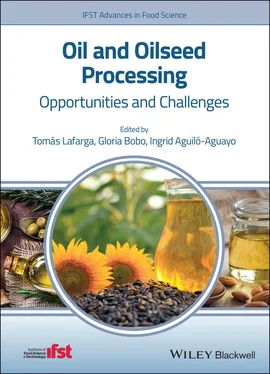Sunflower, safflower, and cottonseed oils are the richest source of vitamin E ( Table 2.2). Sunflower has a high content of α‐tocopherol. Groundnut and cottonseed present balanced levels of α‐ and γ‐tocopherol. Olive oil presents a similar tocochromanol profile to sunflower, however its α‐tocopherol content is lower (Velasco and Ruiz‐Méndez 2015). The content of tocopherol in soybean at pH 6.8 is β‐, γ‐tocopherol 0.27 ± 0.02, δ‐tocopherol 0.47 ± 0.00 and α‐tocopherol 0.02 ± 0.00 mg/g neutral lipid of oil bodies (Chen et al. 2014).
Some phytosterols are important components, they are part of the steroids group, and participate in the chemical defense of the plants, as for example, triterpenoids or campesterol which is one of the most important phytosterols and has a similar structure to cholesterol. Because of this, dietary phytosterols reduce intestinal absorption of cholesterol and reduce its levels (Plat and Mensink 2005). Technologically, phytosterols increase thermal stability of oils with high levels of polyunsaturated fatty acids (Winkler and Warner 2008).
These compounds can be present in the oil in free form or esterified with glucosides, ferulic acid, or fatty acids. Ferulic acid‐esterified sterol is known as oryzanol and has been reported to have diverse health benefits, including hypolipidemic and antioxidant effects or stimulation of growth and hypothalamus activity (Dunford 2004). β‐sitosterol is the phytosterol predominant in the profile of vegetable oils. Brassinosteroids, which are plant hormones essential for normal growth and development (Bishop and Yokota 2001) are present in high concentration in rapeseed oil. Soybean decreases its content of β‐sitosterol with pH changes, at pH 6.8 0.82 ± 0.10 mg/g neutral lipid of oil bodies, at pH 9.5 with 0.73 ± 0.05 mg/g, and at pH 11.0 with 0.62 ± 0.04 mg/g (Chen et al. 2014).
Table 2.2 Composition table from Food Data Central form USDA (values per 100 g of oil).
| OILS |
Energy (kcal) |
Total lipid (g) |
FA total saturated (g) |
FA total MU a (g) |
FA total PU b (g) |
Vitamin E c (mg) |
Vitamin K d (μg) |
| Sunflower oil |
884 |
100 |
10.3 |
19.5 |
65.7 |
41.1 |
5.4 |
| Canola Oil |
884 |
100 |
7.4 |
63.3 |
28.1 |
17.5 |
71.3 |
| Soybean oil |
857 |
100 |
15.7 |
22.7 |
57.7 |
8.2 |
183.9 |
| Groundnut oil |
884 |
100 |
16.9 |
46.2 |
32 |
15.69 |
0.7 |
| Cottonseed oil |
884 |
100 |
25.9 |
17.8 |
51.5 |
35.3 |
24.7 |
| Flaxseed oil |
884 |
100 |
9 |
18.4 |
67.8 |
0.47 |
9.3 |
| Poppyseed oil |
884 |
100 |
13.5 |
19.7 |
62.4 |
11.4 |
‐‐‐ |
| Sesame oil |
884 |
100 |
14.2 |
39.7 |
41.7 |
1.4 |
13.6 |
| Safflower oil |
884 |
100 |
7.5 |
74.8 |
12.2 |
34.1 |
7.1 |
| Olive oil |
884 |
100 |
13.8 |
72.9 |
10.5 |
14.35 |
60.2 |
| Coconut oil |
892 |
99.1 |
82.5 |
6.3 |
1.7 |
0.1 |
0.6 |
a monounsaturated
b polyunsaturated
c α‐tocopherol
d phylloquinone.
Table 2.3 Composition of main fatty acids from oilseed oils.
| Oilseed oil |
Main Fatty Acids |
Quantity (%) |
References |
| Soybean oil |
Palmitic acid C16:0 |
10.42 ± 0.07 |
Zhong et al. (2015) |
| Oleic acid C18:1 |
22.85 ± 0.04 |
| Linoleic acid C18:2 |
53.62 ± 0.05 |
| α‐linolenic acid C18:3 (n‐3) |
7.33 ± 0.07 |
| Sunflower oil |
Palmitic acid C16:0 |
53.8 ± 1.28 |
Ye et al. (2019) |
| Oleic acid C18:1 |
27.8 ± 0.01 |
| Linoleic acid C18:2 |
60.6 ± 0.50 |
| α‐linolenic acid C18:3 (n‐3) |
0.12 ± 0.01 |
| Olive oil |
Palmitic acid C16:0 |
12.0 ± 0.74 |
Skiada et al. (2020) |
| Oleic acid C18:1 |
76.7 ± 1.96 |
| Linoleic acid C18:2 |
6.1 ± 1.60 |
| α‐linolenic acid C18:3 (n‐3) |
0.7 ± 0.07 |
| Sesame oil |
Palmitic acid C16:0 |
8.3 ± 0.01 |
Soldo et al. (2019) |
| Oleic acid C18:1 |
39.8 ± 0.05 |
| Linoleic acid C18:2 |
45.0 ± 0.12 |
| α‐linolenic acid C18:3 (n‐3) |
0.4 ± 0.00 |
| Palm oil |
Palmitic acid C16:0 |
37.1 ± 0.93 |
Ye et al. (2019) |
| Oleic acid C18:1 |
45.9 ± 0.88 |
| Linoleic acid C18:2 |
10.4 ± 0.10 |
| α‐linolenic acid C18:3 (n‐3) |
0.12 ± 0.00 |
| Rapeseed oil |
Palmitic acid C16:0 |
3.6 ± 0.06 |
Ye et al. (2019) |
| Oleic acid C18:1 |
76.4 ± 0.12 |
| Linoleic acid C18:2 |
12.2 ± 0.01 |
| α‐linolenic acid C18:3 (n‐3) |
2.30 ± 0.02 |
| Flaxseed oil |
Palmitic acid C16:0 |
5.1 ± 0.02 |
Ye et al. (2019) |
| Oleic acid C18:1 |
21.0 ± 0.43 |
| Linoleic acid C18:2 |
23.4 ± 0.29 |
| α‐linolenic acid C18:3 (n‐3) |
45.03 ± 0.95 |
One of the compounds most biologically active in vegetable oils is squalene, which is a terpenoid hydrocarbon that in plants is synthesized as a biochemical intermediate of the phytosterol biosynthetic pathway. Squalene is a high‐value compound with some applications in the pharmaceutical and cosmetics industries (Dunford 2004). Virgin olive oil and crude sunflower are rich sources of this compound (Grompone 2005).
Other common compounds in vegetable oils are pigments as carotenoids and chlorophylls. There are two types of carotenoids, xanthophyll and carotenes, where the differences is the presence of oxygen in the molecule or not, respectively. In sunflower oil xanthophyll and lutein are the majority pigments. In sunflower oil β‐carotene is added to increase its oxidation stability because of a synergistic effect with tocopherols (Yanishlieva et al. 2001).
Phospholipids are the major constituents of biological membranes. They have great antioxidant effects due to their activity as metal scavengers, their synergistic action with tocopherols, and their capacity to decompose hydroperoxides (Smouse 1995; Carelli et al. 1997). To maintain the fluidity of membranes, phospholipids have a high degree of fatty acid unsaturation, which make them susceptible to oxidation. Crude sunflower has high levels of phospholipids as phosphatidylcholines, phosphatidylethanolamines, phosphatidylinositols, and phosphatidic acids (Gupta et al. 2002).
2.2.5 Antinutritional Factors
“Antinutritional factors are present in different food substances in varying amounts, depending on the kind of food, mode of its propagation, chemicals used in growing the crop as well as those chemicals used in storage and preservation of the food substances” (Inuwa et al. 2011). Oxalates, phytates, tannins, trypsin inhibitors, and hemagglutinins are examples of antinutritional compounds present in vegetable oils. For example, palm and soybean oil have oxalate content of 4.95 and 1.16 g/kg, respectively, and the lethal dose established for oxalates is 2–5 g/kg. The content of alkaloids in palm oil is 0.16/100 mg and in soybean oils is 16.3/100 mg, where the lethal dose for alkaloids is 20/100 mg (Inuwa et al. 2011; Chatepa et al. 2019).
Читать дальше












